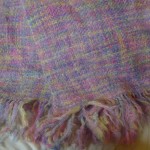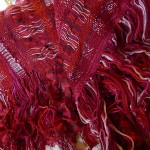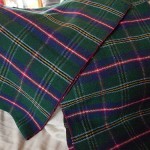Jen entered three handwoven items in the fair this year, and shares pictures of them here in a photo gallery in case you didn’t make it to the fairgrounds to see the real deal!
- The properties that make mohair so deliciously marvelous (fluffy light airiness, fiber halo) are also what make it most difficult to weave. The weaver must take care to prevent snagging all the way from winding the warp onto the loom (the fibers drag against each other, pulling at the equipment that it’s supposed to slide into and through) to winding the shuttle bobbins. An improperly wound bobbin will not release yarn from the shuttle into the cloth). But the mohair blanket wouldn’t be the same with a simpler warp.
- This wrap is woven using 26 different yarns. Instead of playing with color, I decided to stick with one color and instead monkey around with the texture of the piece. Jen’s 17-year-old daughter is just mad about this wrap.
- This is the Washington State Tartan! The fabric was designed by Margaret McLeod van Nus and Frank Cannonito in 1991, with a background of green to represent the rich forests of “The Evergreen State.” The bands of color have the following significance: blue for the lakes, rivers and ocean; white for the snow-capped mountains; red for the apple and cherry crops; yellow for the wheat and grain crops; black for the eruption of Mount St. Helens



